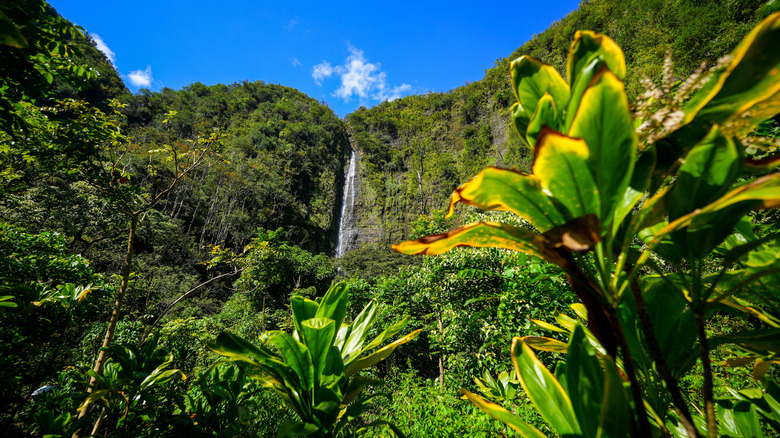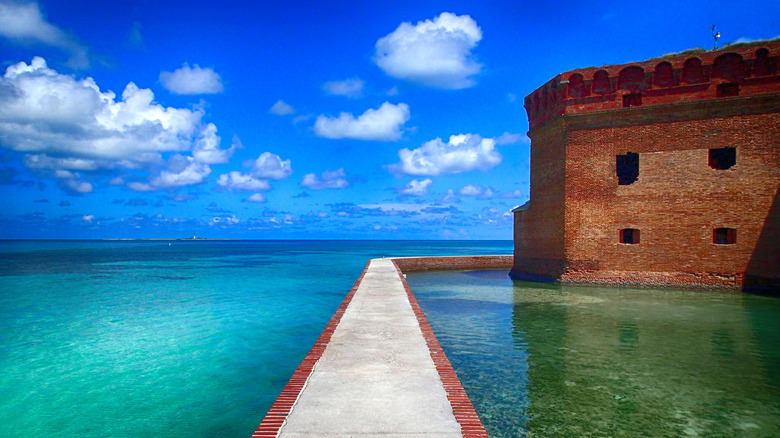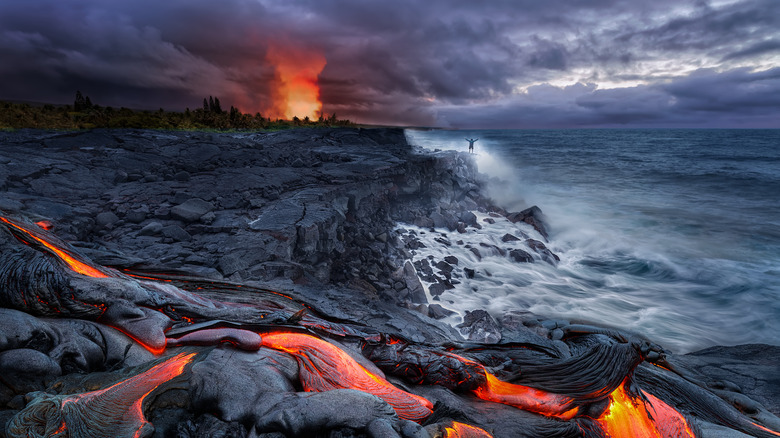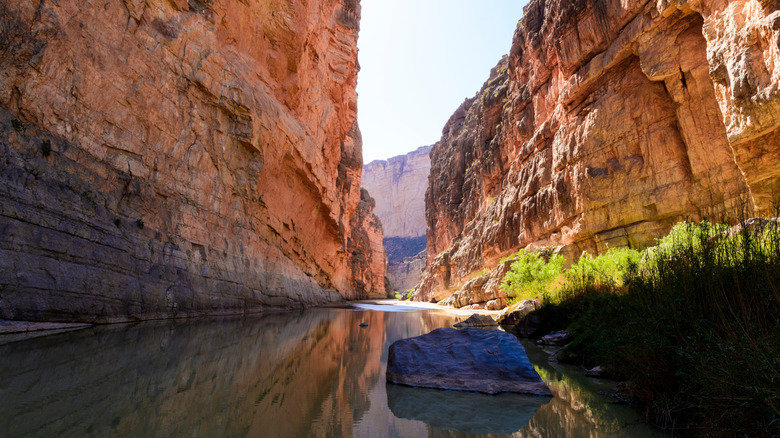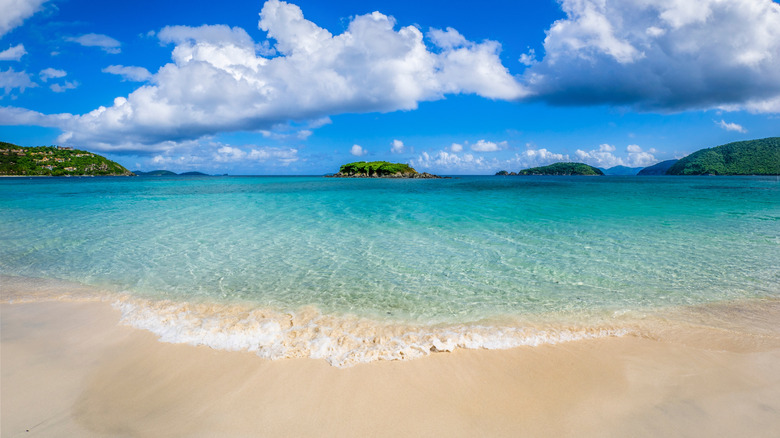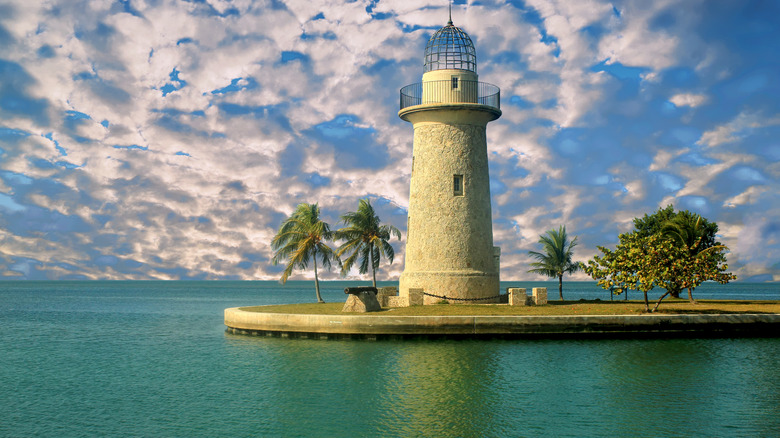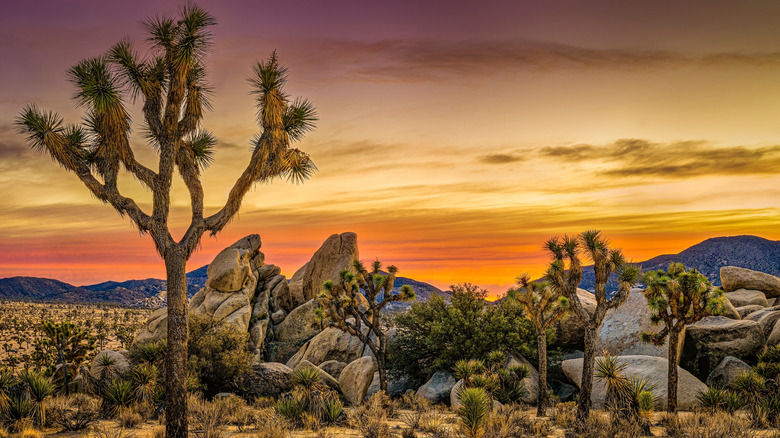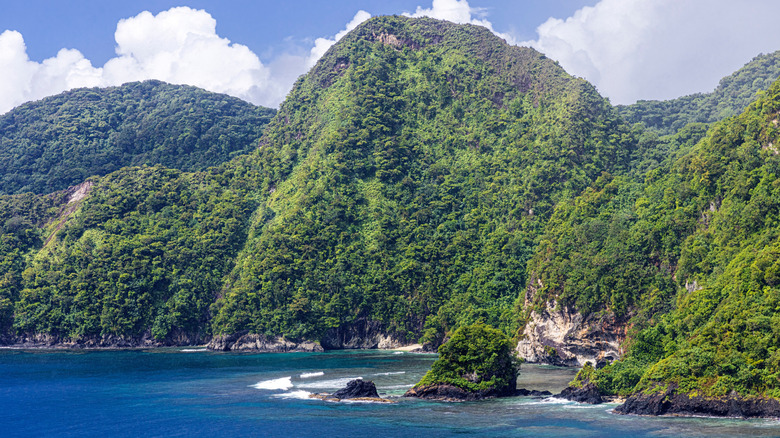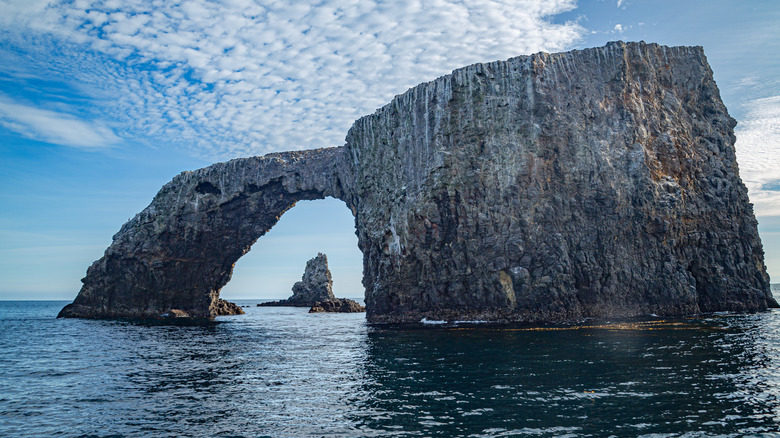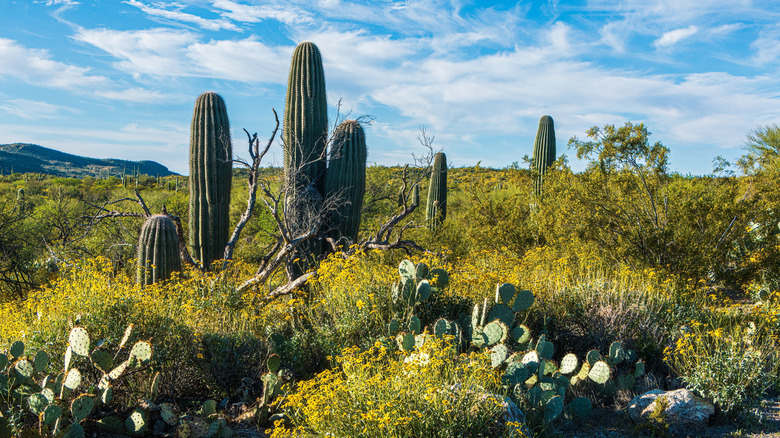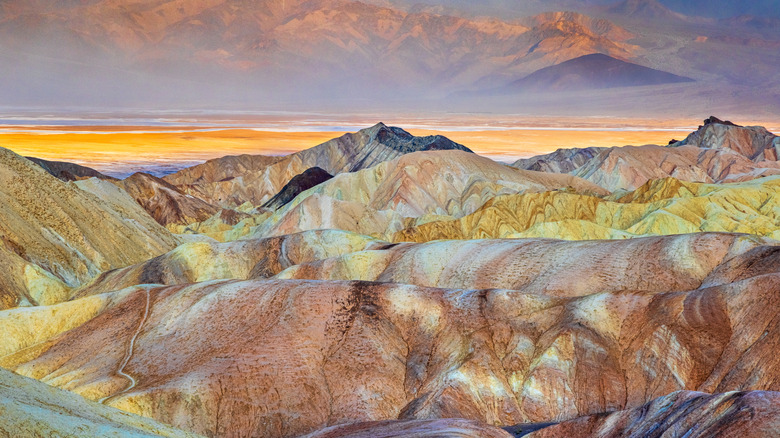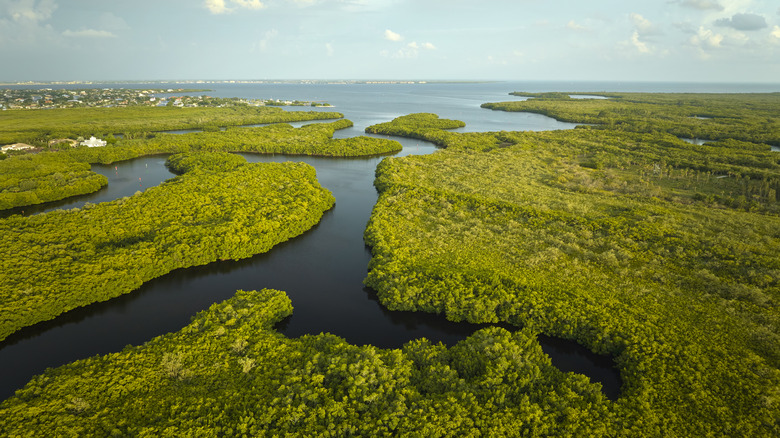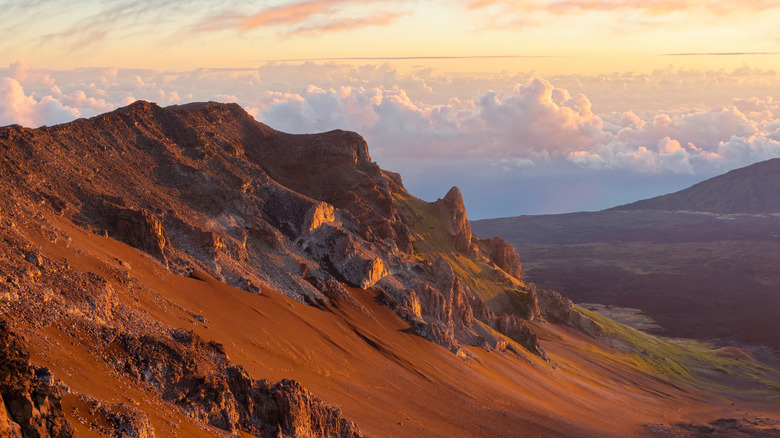The Warmest National Parks To Visit In The Winter
For many of us, the wintertime is usually when we spend as much time indoors as we can, hiding from the cold temperatures, and endlessly daydreaming when beach weather will return. If spending time in nature without freezing sounds like a faraway fantasy at this point, you're in luck. Because as it turns out, there are a number of options out there, that don't even require a passport if you're from the United States.
We've rounded up the best national parks that are still warm during the winter, all of which have something special to offer visitors. We've included options with a wide range of climates and landscapes, whether you're seeking a tropical beach escape, desert scenery, or exciting hikes. Every recommended park has average temperatures of at least 60 degrees Fahrenheit, so you can get the winter escape you're craving this time of year.
Dry Tortugas National Park, Florida
If swimming in azure waters, snorkeling and diving, and just spending as much time in and around the water as possible sounds like your ideal vacation, then Dry Tortugas National Park is one of the best options right in the United States. To get to Dry Tortugas National Park, you have to take a boat or a seaplane, as it's located about 70 miles away from Key West. Across this national park's 100 miles, there are seven separate islands, but it's mostly just made up of water.
As far as sightseeing goes, there's the historic Fort Jefferson, a 19th-century fort that's one of the largest of its kind in the country. Just keep in mind that the surrounding moat wall is currently closed for repairs until fall 2026. Winter is also one of the best times to visit Dry Tortugas, since it's the dry season and you're not at risk for any hurricanes interfering with your vacation. From November until March, temperatures typically range from the mid or upper 60s to the high 70s. The one thing to keep in mind is that the weather can be windier at this time, making the seas rougher and making it potentially feel a bit cooler.
Hawaii Volcanoes National Park, Hawaii
Home to two active volcanoes, Kīlauea and Mauna Loa, Hawaii Volcanoes National Park is one of the best island national parks, and simply unmissable. From seeing a glowing lava lake in the Halemaʻumaʻu crater, to exploring a 500-year-old lava cave, Hawaii Volcanoes National Park is a paradise for the adventurous traveler. With over 100 miles of trails, and 10 possible day hikes, plus a number of longer, more challenging treks as well, there's plenty to see here. While here, don't skip visiting some culturally significant sites, such as Puʻuloa, a sacred place where you can see one of Hawaii's largest petroglyph fields.
Of course, active volcanoes and flowing lava are ever-changing, so be sure to pop into the Visitor's Center before heading off for the day for any up-to-date information about what's available for viewing. Throughout the winter, the temperature in the park ranges from the 50s into the 70s. Just keep in mind that at the summit of the volcanos, (the park goes from sea level all the way to 13,680 feet) temperatures typically 12 to 15 degrees cooler. From stunning landscapes to beautiful culture and history, a visit to Hawaii Volcanoes National Park is a must.
Big Bend National Park, Texas
There's no need to choose between seeing desert or mountains here — Big Bend National Park has it all, from the largest protected area of the Chihuahuan Desert, to Rio Grande Wild, to having the distinct honor of the only national park with an entire mountain range, the Chisos. The wintertime is actually one of the best times to enjoy all that this park has to offer. Winters in Big Bend National Park typically see daytime highs in the mid 70s, making it the perfect temperature for hiking, but be sure to wear layers, as it can get cold by nighttime.
You don't need to even leave the park, either — you can stay at the Chisos Mountain Lodge, or opt for one of the park's four developed campgrounds, or a more backcountry camping experience instead. If you just have one day though, check out the Ross Maxwell Scenic Drive, which offers gorgeous views of the Chihuahuan Desert and Rio Grande, and a visit to the Chisos Basin. You can also explore Santa Elena Canyon, a 1.4 mile round-trip hike, with some of Big Bend's most jaw-dropping views. But plenty of visitors opt for at least a three-day stay or more — there's just that much to see.
Virgin Islands National Park, St. John
If tropical paradise sounds more up your alley for a wintertime vacation, then the U.S. Virgin Islands, is one of the best choices out there. St. John, the smallest of the three main islands, even has a national park of its own — the 5,500-acre Virgin Islands National Park. From gorgeous Caribbean beaches with white sand and crystal-clear water perfect for snorkeling (over 40% of the park is actually underwater), hiking through its 20 stunning trails, and plenty of fascinating history spanning over 3,000 years, a trip to Virgin Islands National Park is truly a bucket list destination any time of year.
But if you really want to escape the cold, this place is for you. During the winter, the average temperature is a perfect 77 degrees and there's less rain. And while there can be stronger winds at this time, instead of bringing cold air they typically just create stronger waves. And there's possibly even more good news, too — there's no entrance pass required to visit Virgin Islands National Park.
Biscayne National Park, Florida
Biscayne National Park is the ultimate eco-tourism destination, and one of the best national parks on the East Coast. The park is 95% water, so expect to spend a lot of time snorkeling, diving, kayaking, checking out colorful coral reef and other sea life, or fishing. Of the park's 173,000 acres, Boca Chita Key is the most visited island, thanks to its historic 1930s lighthouse. Elliott Key is also a great spot for hiking, camping, wildlife spotting, and swimming, but was once known as a community for pineapple farmers and sponging.
To go beyond the Visitor's Center area, a boat will be required — tours with the Biscayne National Park Institute are a popular choice. "Snorkeling in the crystal-clear waters of Biscayne Bay was breathtaking; we saw vibrant coral reefs and colorful fish. The paddle portion was equally enjoyable and thrilling, as we encountered a sand shark and fascinating upside-down jellyfish," shared one past visitor on Tripadvisor. "This experience was not just a fun outing but also an educational journey that deepened my appreciation for the natural beauty and ecological significance of Biscayne National Park." For those looking to visit during the winter, since it's in a subtropical climate, you can expect sunshine and warm weather year-round, with the average temperature hitting 68 degrees in January. No entrance fee is required, but parking, camping, or other transportation fees may apply.
Joshua Tree National Park, California
With unique rock formations, gorgeous desert landscapes, and its namesake, the distinct Joshua trees, Joshua Tree is one of the best options on the West Coast for a winter escape, and it's only an hour or so away from the breathtaking Palm Springs. Winter is a great time to visit to avoid the crowds and the sweltering heat. Typically, it is around 60 degrees during the day, which is ideal for exploring Joshua Tree's 300 miles of trails Prospective campers should keep in mind that it can reach freezing temperatures during the night. But those hoping to stargaze will be in luck, since the sun can set as early as 4:30 p.m. in the winter, meaning you have plenty of time to take in the gorgeous views. While at first glance it may seem like a barren desert, Joshua Tree has a number of different habitats, from oases, to sand dunes, valleys, and mountains, throughout its 1,200 square miles.
As you explore, be on the lookout for creatures like white-tailed antelope ground squirrels, coyotes, foxes, bobcats, bighorn sheep, and mule deer, not to mention plenty of bird and reptile species. "Amazing park! I went for a day visit but definitely could have stayed longer and hope to return," said one past visitor on Tripadvisor. "There's a lot to see, especially for a desert-lover like me."
American Samoa National Park, Tutuila
If you want to get as far away as possible from any semblance of winter, then a trip to American Samoa National Park is the best choice for you. In fact, American Samoa, which is a U.S. territory located some 2,600 miles or so away from Hawaii, doesn't even really have a winter, but a wet summer season from October through May and a somewhat cooler dry season from June to September. Throughout the year, temperatures range from high 70s to the low 90s, with high humidity and frequent rain.
As for the park, which stretches across three volcanic islands, Tutuila, Ta'ū, and Ofu, it's an opportunity to see pristine coral sand beaches, coral reef, lush rainforests and surrounding mountains, and just unparalleled beauty all around. From snorkeling, to hiking, to learning about Samoan culture in Tutuila's villages, American Samoa is truly a dream destination. Just be sure to be mindful of local customs and culture before visiting, such as dressing modestly and asking permission before entering villages. As one of the most remote national parks, to get here, you'll have to fly into Pago Pago International Airport in Tutuila, then take smaller flights to Ta'ū and Ofu.
Channel Islands National Park, California
Known as America's Galapagos Islands, Channel Islands National Park is just 22 miles off of Santa Barbara's coast, but feels like a world away. Spread across five different islands, Channel Islands National Park has a range of activities to offer visitors, from camping, to water sports, to hiking. For one of the park's most stunning views, head to Inspiration Point on Anacapa Island. Although there are just two miles of trails here, it's a popular choice for those who have just one day in the park. Apart from hiking, it's a gorgeous spot for diving, swimming, and snorkeling, as well as seeing wildlife like seals, sea lions, plenty of birds, and during the late winter, wildflowers, which just add to the island's already unparalleled scenery.
Apart from spending time in nature, the Channel Islands are also brimming with history that extends 12,000 years. Each island has its own history and stories to tell, from serving as the original home for the native Chumash, to colonization and playing a role in California's ranching history, and beyond. With a Mediterranean climate, temperatures typically hang around the 50s and 60s year-round. Regardless of when you visit, visitors should dress in layers, and prepare for unpredictable weather conditions like winds, rough seas, or fog. No entrance fee is required here.
Saguaro National Park, Arizona
As the name suggests, the highlight of Saguaro National Park is in fact, the saguaros. These giant cacti sometimes reach heights up to 50 feet tall, and typically live from 150 to even 200 years old. They also require specific conditions to grow, and as a result, they are only found in certain parts of the Sonoran Desert. These iconic plants have become a symbol of the American southwest, and exploring the park's numerous hiking trails are the best ways to experience the incredible desert scenery. "Just wow!" said one previous visitor on Tripadvisor. "One of the highlights of my trip to Arizona, just amazing driving and walking among these huge cacti, an absolute must do experience for all ages."
Since the summertime usually reaches temperatures over 100, winter is the perfect time to safely enjoy Saguaro National Park. Daytime temperatures are typically in the mid-60s, but can also reach the mid to upper-70s, although higher elevations in the park reach colder temperatures, and sometimes, even snow.
Death Valley National Park, California and Nevada
One of the best national parks near Los Angeles is Death Valley National Park — and despite its somewhat frightening name, this is a surprisingly pleasant place to visit, at least in the winter. Throughout the park, there are fascinating sights to see, from a volcanic crater, to the picturesque Rainbow Canyon, to beehive-shaped buildings used for 19th-century mining operations, and winter is by far the best time to hike and explore. In fact, in the summer, you'll definitely want to avoid Death Valley, as temperatures can reach upwards of 130 degrees. Summers are long in Death Valley, and even the shoulder seasons can bring scorching temperatures.
In the winter, however, daytime temperatures fluctuate, sometimes in the 50s, and 60s, but other times, into the 70s and 80s. If camping, and/or stargazing, winter nights can sometimes get below freezing, particularly in areas of higher elevation, so be sure to bring lots of layers. "Death Valley is wonderful in the winter," said one Redditor. "You'll still have warm days and usually don't have to worry about being indoors by 10am, although it can still get very hot even in December."
Everglades National Park, Florida
Spanning a whopping 1.5 million acres, Everglades National Park is the largest subtropical wilderness in the country, and the ultimate destination for fans of the outdoors. Whether you love hiking, biking, wildlife spotting, camping, or kayaking, there's something for you here. Because it's so big, visiting does require a bit of planning, and there are four different entrances, depending on what you're hoping to do during your visit.
There's an abundance of wildlife here, from rare and endangered species like manatees, American crocodiles, and even Florida panthers, plus plenty of other animals like otters, dolphins, alligators, and over 300 types of birds. If you're looking for a relatively short trail, the Anhinga Trail is a great choice, offering a chance to see animals like alligators, turtles, herons, and more. While the winter is a great time to visit for an escape from the cold (temperatures typically range from the 50s to the mid-to-high 70s), keep in mind that this is a popular time to visit, so it will likely be more crowded than other times of the year. "Our first National Park experience and it didn't disappoint!!!" said one Tripadvisor reviewer. "So much wildlife and beauty to see, you could spend days coming back and see something different each time!!!"
Haleakalā National Park, Hawaii
From volcanic landscapes to sub-tropical rain forests, Hawaii's Haleakalā National Park is truly special. Known as the "House of the Sun," a visit to this national park is one of the absolute best things to do during a trip to Maui. "It's so magical and something that would make you feel you are in your dream, but it's greater!" said one past visitor on Tripadvisor about their trip to the park. Apart from appreciating its jaw-dropping landscapes, the park also is home to a number of sacred and culturally significant sites, as well as important ecosystems and endemic species.
As a park with various elevations, temperatures can vary, with the Kīpahulu area of the park — where you can see gorgeous sites like waterfalls, rainforests, ocean views, and the Seven Sacred Pools of ʻOheʻo — generally reaching 70 to 80 degrees year-round, while at the top of the summit — 10,023 feet higher — it can be 30 degrees colder. At the summit, however, is where you can see views that are truly out of this world, especially during sunrise or sunset, or for stargazing.
